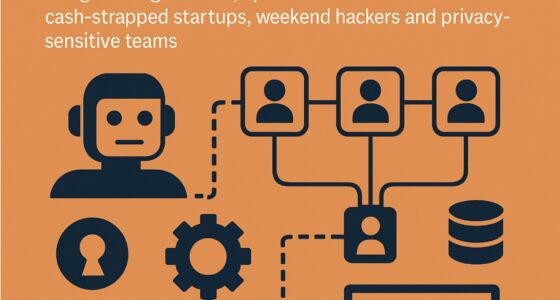AI is now actively fighting bias in workplaces by identifying and reducing unfair practices through tools like bias detection and automated audits. Organizations are tracking diversity metrics, analyzing algorithms, and implementing inclusive policies with better data insights. Leadership plays a key role in embedding DEI efforts into core strategies. As AI evolves, it will continue to support more equitable workplaces—if you explore further, you’ll discover how these innovative solutions are shaping a more inclusive future.
Key Takeaways
- AI tools automate bias detection and auditing, identifying unfair practices in hiring, promotion, and performance evaluations.
- Data-driven dashboards and analytics help organizations monitor and improve workforce diversity and inclusion metrics.
- Incorporating diverse perspectives during AI development reduces blind spots and minimizes algorithmic biases.
- Continuous AI monitoring ensures fairness, transparency, and alignment with organizational DEI goals.
- Embedding AI-driven inclusion strategies enhances innovation, employee engagement, and workplace equity.
The Current State of Diversity in AI Workforce

Despite growing awareness of the importance of diversity, the AI workforce remains largely homogeneous, with predominant representation from white, male individuals. You’ll notice most AI research and development teams are concentrated in North America and Europe, where diversity is limited. Women make up less than 10% of staff at major tech firms, and Black employees account for under 5%. This lack of representation influences the systems created, risking biases that overlook or misrepresent underrepresented groups. When teams lack diverse perspectives, AI tools may unintentionally reinforce stereotypes or exclude certain communities. Achieving inclusivity requires expanding your talent pool to include varied backgrounds, experiences, and viewpoints. Only then can AI systems better serve all users and foster a truly inclusive technological landscape. Maximize Space and Organization
Leveraging Data to Track and Improve DEI Initiatives

Using data to track DEI initiatives helps you identify where your organization stands and pinpoint areas needing improvement. By establishing clear metrics for inclusion, you can monitor progress and measure the impact of your efforts over time. Effective gap analysis guarantees your DEI strategies stay targeted and responsive to real workplace dynamics. Incorporating beneficial ingredients like collagen and hyaluronic acid into assessments can provide insights into how different initiatives affect employee well-being.
Metrics for Inclusion
Leveraging data to track and improve DEI initiatives enables organizations to make informed decisions and demonstrate tangible progress. By establishing clear metrics, you can measure workforce diversity across attributes like race, gender, and ethnicity, providing a concrete view of representation gaps. Setting specific, measurable goals—such as increasing underrepresented groups or improving retention rates—helps keep your efforts focused. Regularly analyzing these metrics reveals trends over time, highlighting areas needing attention or adjustment. Data visualizations and dashboards make complex information accessible, fostering accountability. Importantly, tracking inclusion isn’t just about numbers; it also involves capturing employee experiences and perceptions through surveys. This holistic approach ensures your DEI initiatives are impactful, progressive, and aligned with organizational values. Incorporating trustworthy data sources can further enhance the accuracy and credibility of your DEI tracking efforts.
Data-Driven Gap Analysis
Data-driven gap analysis empowers organizations to identify where their DEI efforts fall short by systematically examining workforce data. You gather detailed demographic information, including race, gender, and other attributes, to pinpoint underrepresented groups. AI tools analyze this data to reveal disparities in hiring, promotion, retention, and pay. With these insights, you can prioritize areas needing intervention and set measurable goals. This process also helps uncover unconscious biases embedded in organizational practices, guiding targeted training and policy adjustments. By continuously evaluating data, you maintain an objective view of progress, avoiding assumptions or bias-driven judgments. For example, understanding the impact of contrast ratio in visual representations can be akin to analyzing disparities in perceptions of fairness, helping to craft clearer, more effective DEI strategies. Ultimately, data-driven gap analysis enables you to craft more effective, evidence-based DEI initiatives, fostering an inclusive environment rooted in transparency and accountability.
Tracking Progress Effectively
How can organizations guarantee their DEI efforts lead to real change? The key is tracking progress with precision. Use AI-powered analytics to monitor workforce demographics, hiring trends, and retention rates continuously. Set clear, measurable goals—like increasing representation of underrepresented groups—and leverage data to assess whether you’re meeting them. Automate reporting to ensure transparency and accountability across teams. Regularly audit your AI tools to spot biases or gaps that might skew results. Engage leadership with real-time dashboards that highlight progress and areas needing improvement. By systematically measuring outcomes, you can refine strategies, celebrate successes, and address setbacks promptly. This data-driven approach guarantees your DEI initiatives stay focused, effective, and aligned with your organization’s broader inclusion goals.
Recognizing and Addressing AI Bias Risks

Recognizing and addressing AI bias risks is crucial because biased algorithms can reinforce existing inequalities and exclude underrepresented groups. You need to understand that AI systems learn from historical data, which often contains biases. Without careful scrutiny, these biases can perpetuate discrimination in hiring, promotions, and workplace evaluations. Regularly auditing algorithms for fairness helps identify unintended biases early. Incorporate diverse perspectives during development to challenge narrow norms and reduce blind spots. Transparency about data sources and decision-making processes builds trust and accountability. You should also promote ongoing training for teams on bias awareness. Additionally, staying informed about advances in machine learning algorithms can help in designing more equitable AI systems. By proactively managing bias risks, you guarantee AI tools support inclusivity rather than undermine it, creating a fairer environment where all employees can thrive.
Tools and Technologies for Inclusive Workplace Practices

You can leverage AI tools like demographic analysis to identify diversity gaps and target inclusion efforts. Automated compliance monitoring helps guarantee policies are followed and progress is tracked efficiently. Bias detection tools enable you to spot and address unintended prejudices in hiring, retention, and workplace practices. Incorporating Honda Tuning techniques can inspire innovative approaches to customizing and refining workplace inclusion strategies.
AI Demographic Analysis
AI demographic analysis tools are transforming inclusive workplace practices by providing organizations with detailed insights into workforce composition. These tools examine data on race, ethnicity, gender, age, and other attributes to identify diversity gaps and areas needing improvement. By analyzing hiring, retention, and promotion patterns, you can uncover biases and disparities that might otherwise go unnoticed. This data helps you set measurable DEI goals and track progress over time. AI-driven insights enable targeted interventions, such as inclusive recruitment strategies or training programs. With real-time dashboards, you gain ongoing visibility into your organization’s demographic makeup. Additionally, understanding the role of essential oils for diversity, such as Lavender and Peppermint oils, can promote a calming and inclusive environment that supports employee well-being. Ultimately, these tools empower you to make informed decisions, foster a more equitable environment, and ensure that diversity and inclusion are integrated into your core business practices.
Automated Compliance Monitoring
Building on AI demographic analysis, automated compliance monitoring tools streamline how you track adherence to diversity policies and legal requirements. These tools continuously analyze hiring, promotion, and retention data to identify gaps or violations. They flag inconsistencies in real time, enabling proactive intervention. By automating reporting processes, organizations reduce manual errors and increase transparency. These systems also generate compliance dashboards, making it easy to visualize progress and accountability. Incorporating best practices from the industry ensures these tools are effectively integrated into existing HR workflows.
Bias Detection Tools
Bias detection tools are essential for identifying and mitigating unfairness in workplace systems. These tools analyze algorithms, hiring data, and employee feedback to uncover hidden biases that may disadvantage underrepresented groups. By scrutinizing recruitment algorithms, performance assessments, and promotion patterns, you can pinpoint where disparities occur. Automated audits help ensure your AI systems align with diversity and inclusion goals, preventing reinforcement of stereotypes. These tools provide actionable insights, enabling you to adjust processes and improve fairness. Regular monitoring is vital to catch biases early and maintain ethical standards. Implementing bias detection tools fosters transparency and accountability, helping you build a more equitable workplace. Additionally, incorporating AI in Education innovations can enhance training programs aimed at reducing bias. Ultimately, they empower you to make data-driven decisions that promote diversity, inclusion, and organizational success.
The Business Benefits of Embracing Diversity Through AI

Embracing diversity through AI offers tangible business advantages that can drive growth and innovation. When you leverage AI to identify gaps and foster inclusion, you open a broader range of perspectives that enhance problem-solving and creativity. Diverse teams, supported by data-driven insights, tend to outperform their less inclusive counterparts financially, leading to higher profitability and market share. Additionally, inclusive workplaces boost employee engagement and retention, reducing turnover costs. Using AI to track and improve DEI metrics helps you set measurable goals and demonstrate progress, building trust among stakeholders. Furthermore, a reputation for valuing diversity attracts top talent, especially from younger generations who prioritize inclusive environments. Incorporating AI Security ensures that sensitive data used in these initiatives remains protected. Overall, integrating AI into your DEI strategy transforms your business into a more resilient, innovative, and competitive organization.
Strategies for Embedding Inclusion Into Core Business Goals

You need to embed inclusion into your core business goals by aligning DEI initiatives with your overall strategy. Setting measurable inclusion targets helps track progress and holds your organization accountable. Fostering inclusive leadership ensures your team effectively champions diversity and sustains these efforts long-term.
Align DEI With Strategy
Embedding diversity, equity, and inclusion (DEI) into your core business strategy requires more than isolated initiatives; it demands a deliberate integration that aligns DEI goals with overall organizational objectives. To do this effectively, you need to incorporate DEI metrics into decision-making processes, ensuring leadership accountability and consistent progress tracking. Use AI-driven analytics to identify gaps in representation, retention, and inclusion, making data-driven adjustments aligned with your strategic priorities. Incorporate DEI into performance evaluations, resource allocation, and innovation targets. By embedding DEI into your strategic framework, you create an environment where inclusion drives business growth, enhances creativity, and strengthens your competitive edge. This approach guarantees DEI is not an add-on but a fundamental element of your organization’s success.
Set Measurable Inclusion Goals
To effectively integrate inclusion into your core business goals, it’s essential to establish clear, measurable objectives that track progress over time. Define specific DEI metrics, such as representation targets for underrepresented groups, retention rates, and inclusive culture surveys. Use AI-powered tools to gather accurate data and set realistic, data-driven benchmarks. Regularly review your progress, adjusting strategies as needed to close gaps. Incorporate these goals into performance reviews and leadership accountability frameworks to ensure commitment across levels. Transparent reporting of your progress fosters trust and demonstrates your organization’s dedication to inclusion. By setting measurable goals, you create a focused roadmap that aligns diversity efforts with broader business success, making inclusion an integral part of your organization’s growth.
Foster Inclusive Leadership
How can organizations guarantee that inclusive leadership becomes a core element of their business strategy? You need to embed inclusion into leadership development and decision-making processes. Start by prioritizing diverse representation in leadership roles and providing ongoing bias training. Use AI tools to identify gaps in leadership diversity and monitor progress toward inclusive goals. Encourage leaders to champion DEI initiatives and hold them accountable through clear metrics. Cultivate psychological safety so team members feel empowered to share diverse perspectives. Promote transparency around inclusion efforts and integrate DEI into performance reviews. By aligning leadership objectives with inclusive practices, you foster a culture that values diversity at every level, ensuring inclusion isn’t just a policy but a fundamental part of your organization’s identity and success.
Overcoming Challenges in Implementing AI-Driven DEI Solutions

Implementing AI-driven DEI solutions often faces significant hurdles, from technical biases to organizational resistance. You might find that AI systems reflect existing biases if not properly designed, leading to unfair outcomes. Data quality is another challenge; incomplete or skewed data can produce misleading insights. Resistance from leadership or staff can slow adoption, especially if they distrust automated tools or fear job impacts. Additionally, integrating AI into existing workflows requires resources and expertise many organizations lack. Maintaining transparency is vital, but complex algorithms can obscure decision-making processes, raising ethical concerns. Overcoming these obstacles demands continuous auditing, inclusive team development, and clear communication. By addressing these challenges head-on, you guarantee AI tools genuinely promote fairness and inclusion, rather than unintentionally reinforcing biases.
The Role of Leadership in Promoting Inclusive AI Practices

Effective leadership is essential in fostering inclusive AI practices, as it sets the tone and priorities for organizational culture. You need to champion diversity and guarantee AI development aligns with ethical standards. This means actively promoting diverse hiring, supporting ongoing education, and holding teams accountable for bias mitigation. Leaders must understand AI’s potential biases and advocate for transparency and fairness in algorithms. By embedding inclusion into strategic goals, you create a workplace where diverse perspectives inform AI development. You also influence resource allocation, ensuring teams have access to tools and training that promote equitable practices. Your commitment signals organizational value for inclusion, encouraging others to follow suit. Ultimately, strong leadership drives sustainable change, making AI a force for workplace equity rather than bias.
Global Perspectives and Regional Variations in AI DEI Efforts

Global efforts to advance AI diversity and inclusion vary markedly across regions, reflecting differing cultural norms, economic priorities, and political will. In North America and Europe, there’s a growing focus on data-driven DEI strategies, with many companies adopting AI tools to identify gaps and improve representation. These regions often lead in setting standards for ethical AI and inclusive practices. Conversely, Asia and Africa face unique challenges, such as limited resources, differing perceptions of diversity, and regulatory gaps, which slow progress. Some regions show resistance to implementing AI DEI initiatives, citing concerns over privacy or cultural differences. As a result, regional variations influence how organizations approach inclusive AI, with some making significant strides while others lag behind, highlighting the need for tailored, culturally sensitive strategies.
Future Trends Shaping AI and Workplace Inclusivity

As organizations recognize the uneven progress in regional DEI efforts, a clear shift is emerging toward embedding inclusivity into core business strategies. You’ll see companies integrating AI-driven tools to set measurable goals, automate compliance, and analyze workforce data. This shift emphasizes proactive inclusion, moving beyond reactive programs. Leadership skills are increasingly prioritized to manage diverse teams effectively. AI is viewed as essential for fostering innovation, improving retention, and meeting evolving employee expectations. However, regional resistance persists, demanding ongoing education and cultural change. To stay ahead, you must embrace continuous learning and ensure AI tools are designed ethically. This evolving landscape signals a future where AI is central to making workplaces truly inclusive.
| Trend | Impact |
|---|---|
| Embedding inclusion | Core business strategy |
| Leadership development | Managing diversity effectively |
| Data-driven DEI | Setting measurable goals and tracking progress |
| Ethical AI design | Reducing bias and ensuring fairness |
Frequently Asked Questions
How Can Companies Ensure AI Tools Don’t Reinforce Existing Biases?
You can guarantee AI tools don’t reinforce biases by regularly auditing and testing them for fairness. Incorporate diverse development teams to identify blind spots and avoid homogeneous perspectives. Use transparent algorithms and set clear diversity goals. Continuously monitor outcomes, adjust models as needed, and involve underrepresented groups in feedback. This proactive approach helps create unbiased AI that promotes genuine inclusion and prevents perpetuating existing inequalities.
What Measures Promote Trust and Psychological Safety in Ai-Driven DEI Initiatives?
You can build trust and psychological safety in AI-driven DEI initiatives by involving employees in the development process. For example, imagine a company creates a feedback platform where staff anonymously share concerns about AI biases. This inclusion shows you value their input, fostering transparency and trust. Regularly auditing AI systems and openly communicating improvements also reassure employees, making them feel safe and confident that their voices influence positive change.
How Does AI Improve Recruitment and Retention of Underrepresented Groups?
AI improves recruitment and retention of underrepresented groups by analyzing workforce data to identify gaps and biases, enabling targeted outreach and inclusive hiring practices. It automates compliance, broadens talent pools, and highlights disparities, helping you create fairer processes. Additionally, AI-driven insights support ongoing diversity efforts, fostering a more welcoming environment. As a result, you’ll attract diverse candidates and increase retention, benefiting from varied perspectives and innovative problem-solving.
What Skills Are Essential for Leaders Managing Diverse AI Teams?
Think of leadership as planting a garden—your skills are the seeds that nurture diversity. Essential skills include cultural intelligence to understand different perspectives, active listening to foster trust, and adaptability to navigate change. You also need emotional intelligence to build psychological safety and empathy. By cultivating these qualities, you create an environment where diverse AI teams thrive, innovate, and grow together, enriching your organization’s future.
How Are Regional Cultural Differences Affecting AI DEI Implementation Worldwide?
You’ll notice regional cultural differences influence DEI implementation by shaping attitudes toward diversity and inclusion. In some regions, societal norms may resist change, making it harder to adopt inclusive AI practices. Conversely, other areas prioritize diversity, fostering supportive environments. You need to adapt strategies to local cultural contexts, ensuring your AI initiatives resonate and effectively address unique workforce needs. This tailored approach helps maximize AI’s positive impact on workplace inclusivity globally.
Conclusion
As you navigate the evolving landscape of AI and workplace diversity, remember you’re steering a powerful ship through uncharted waters. Embrace technology as your compass, guiding you toward inclusion’s horizon. Every bias you confront and every tool you adopt is a stroke in painting a richer, more vibrant workplace. With conscious leadership and innovative spirit, you’re not just riding the waves of change—you’re shaping a future where everyone’s voice echoes in harmony.









